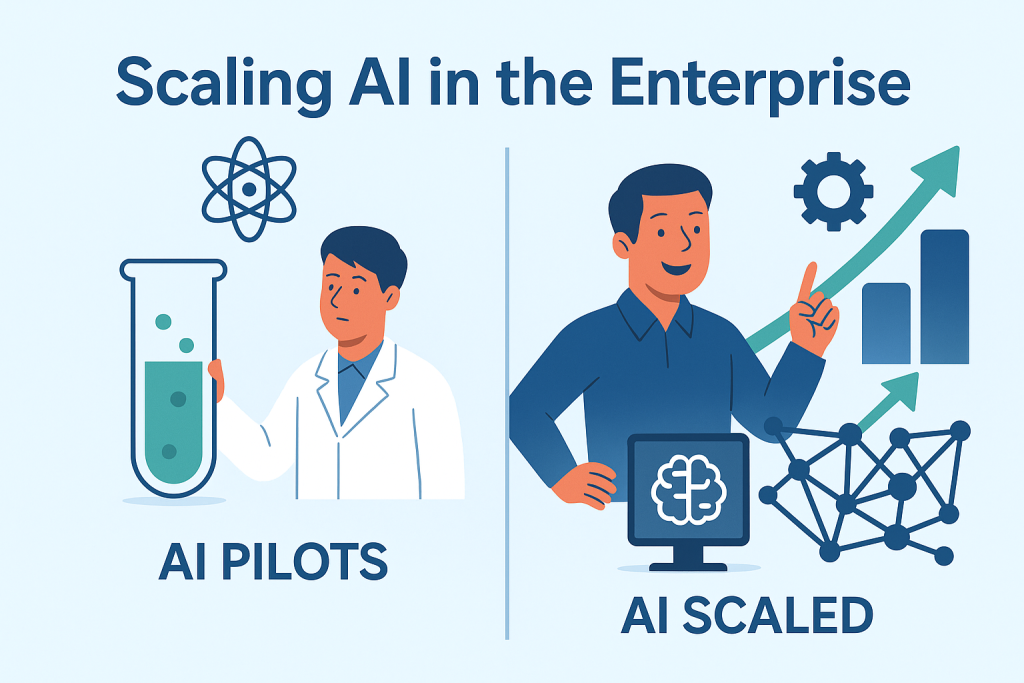Artificial Intelligence (AI) has been the most hyped enterprise technology of the past decade. Yet despite the hype, many enterprises remain stuck at the pilot and proof-of-concept stage. They experiment with chatbots, dabble in predictive analytics, or test automation in a single department—but never scale these initiatives enterprise-wide.
The result is a familiar frustration: high investment, low return, and a sense that AI is “not ready” for their business. The truth? AI is ready. What’s missing is a roadmap to move beyond pilots into scalable, measurable adoption.
Why Enterprises Stall at Pilots
1. Lack of Clear Business Outcomes
Too many AI projects start with technology, not strategy. Enterprises test “what AI can do” without aligning projects to business outcomes like reducing churn, increasing cash flow, or cutting compliance costs.
2. Poor Data Readiness
AI relies on clean, connected data. Legacy systems and siloed databases leave enterprises without the single source of truth needed to train effective models. Without solid data foundations, pilots struggle to perform.
3. Change Resistance
Staff often view AI as a threat rather than an opportunity. Without change management, pilots face pushback, low adoption, and lack of trust in results.
4. Lack of Governance
Without clear frameworks for privacy, ethics, and accountability, enterprises hesitate to roll out AI at scale. Gartner notes that 65% of enterprises cite governance as the top barrier to AI adoption.
5. Over-Focus on “Innovation Labs”
Many enterprises relegate AI to innovation hubs that are disconnected from the core business. Pilots remain academic exercises instead of operational tools.
The Path to Scaling AI
Tie AI to Business Strategy
AI projects should begin with outcomes, not algorithms. Enterprises must ask: What business problem are we solving? From cutting invoice processing time to predicting supply chain disruptions, every AI use case must deliver measurable ROI.
Build on Clean, Standardised Data
Enterprises must first standardise data across CRMs, ERPs, and finance systems. Without this foundation, AI outputs will be fragmented or unreliable.
Phased Rollout Approach
Just as with broader digital transformation, AI scaling works best in phases:
- Phase 1: Automate routine, low-risk processes (e.g. invoice matching, customer FAQs).
- Phase 2: Integrate predictive models into operations (e.g. demand forecasting, risk scoring).
- Phase 3: Scale advanced AI like natural language processing and decision automation across regions.
Invest in Change Management
Engage staff early, train “AI champions,” and communicate how AI will augment, not replace roles. Enterprises that do this see adoption soar.
Establish Governance Frameworks
Successful enterprises create clear policies around data privacy, model transparency, and accountability. This gives leadership the confidence to scale AI responsibly.
Case in Point: From Pilot to Enterprise Value
A global logistics firm piloted AI for delivery route optimisation. Initially limited to one region, the project showed fuel savings of 12%. Instead of leaving it as a one-off pilot, leadership rolled it out globally, integrated it with CRM and fleet management systems, and achieved annual savings in the tens of millions.
The difference? A commitment to scale, backed by data readiness, governance, and clear ROI metrics.
The Bottom Line
AI is no longer experimental—it’s operational. The enterprises that move beyond pilots and scale AI strategically will not only cut costs but also gain agility, resilience, and competitive edge.
The future of enterprise AI won’t be defined by who runs the most pilots. It will be defined by who scales.

